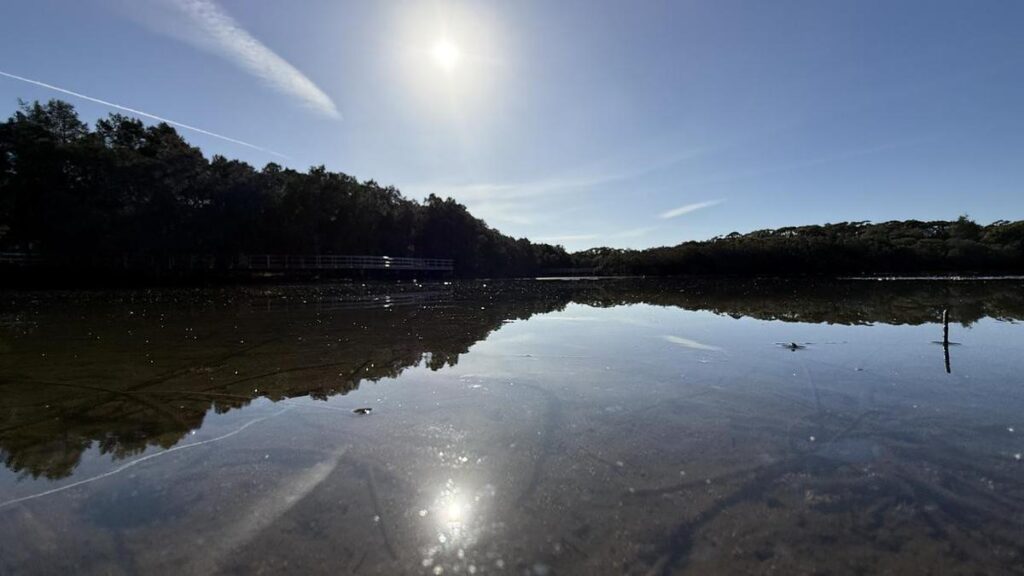Healthy, well-balanced coastal lagoons at the intersection of salty seas and fresh waterways make ideal fish nurseries and attractive spots for migratory birds.
Yet a warming climate paired with competition for water upstream is degrading these ecological hotspots, ramping up their salt content and putting marine life under stress.
Emerging research suggests the potential for lagoon wetlands to act as carbon sinks – when an ecosystems draws down more carbon dioxide than it releases – is hindered when in a degraded state.
University of Adelaide microbial ecologist Christopher Keneally said the habitats tend to emit more methane and nitrous oxide, both potent greenhouse gas emissions, when in poor shape.
His post-doctoral research focused on the Ramsar-listed Coorong in South Australia, the traditional lands of the Ngarrindjeri people, underlines the importance of keeping these critical habitats in good health.
It’s not just an Australian problem, he explained, with brackish wetlands in arid and temperate climate zones worldwide under threat from rising temperatures.
Characterised by somewhat choked ocean access, lagoons are already under pressure from human activity as freshwater use by towns, farms and industry leaves less for the environment at the end of river basins.
Now higher rates of evaporation under rising temperatures, less rainfall, and sea level rise bringing in more saltwater from the ocean are contributing to higher salt and nutrient concentrations.
“A single hot, dry summer, like the one we have recently experienced, can completely shift this important habitat into a salty, green soup,” Dr Keneally said.
Such conditions upset the invisible and delicate “microbiomes” of lagoon waters, with microbial diversity diminished while salt-tolerant species survive.
Unbalanced microbial communities can potentially lead to harmful algae blooms and low-oxygen “dead zones” that kill fish.
In addition, microbial species with anaerobic metabolisms favour high salinity environments. These species tend to produce methane, undermining the habitat’s role as a productive carbon sink.
While an emerging area of research, Dr Keneally said estimations of methane production were “probably underestimated” and should be better integrated into global climate models.
Occasional heavy rainfall and floods serve to “freshen up” coastal wetlands, rebalancing salt and other nutrient levels, as occurred in the South Australia’s Coorong region in 2022.
Yet sporadic downpours cannot be relied upon.
“Conditions might improve for a couple of years, but those high rainfall events are not dependable, and in the dry periods, we often see permanent losses of biodiversity, Dr Keneally said.
Careful management of freshwater releases to keep salinity and nutrient levels at optimal levels was billed as part of the solution.
Listed as an internationally-important wetland under the Ramsar convention for migratory birds in the 1980s, the Coorong has long been a research priority and its condition taken seriously.
The Millennium Drought led to the creation of the Murray Darling Basin to better manage water flows in the region, though balancing the needs of irrigators, towns and the environment has long been a fraught issue.
Long-time Coorong fisherman Glen Hill believes the limited water reserved for the environment – half the amount recommended by scientists – should be released more strategically.
The owner of Coorong Wild Seafood said the north of the lagoon was in great shape as freshwater from the river mouth could be easily released into it, while the more isolated south area was in a “terrible” state.
He said better-timed water releases to coincide with favourable winds and weather conditions could help more freshwater enter the troubled southern lagoon.
Mr Hill has been fishing the area for the prized Yellow-eye mullet and other commercially-important species for decades.
Situated at the end of the Murray Darling Basin, Mr Hill said the Coorong was a highly productive fishery thanks to the high levels of nutrient “building blocks” swept downstream.
Yet he was acutely familiar with the “domino effect” of harmfully-high salinity levels, knocking out species low on the food chain and leaving fish with little to eat.
“When you get to around two times sea water salinity, things start to really go wrong,” he said.
A spokesperson from the South Australian Department for Environment and Water said the government was committed to protecting the Coorong’s ecological character.
“This work is achieved by optimising delivery of water for the environment and investing in infrastructure and restoration strategies to improve and protect the health of the system,” the spokesperson said.
The health of the lagoon vastly improved during the 2022 River Murray floods but the spokesperson said more needed to be done to restore its long-term health.
This included refining freshwater flows and working with other basin states to ensure climate science informs its broader management.

